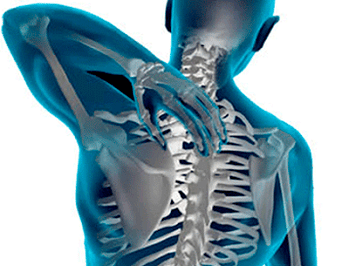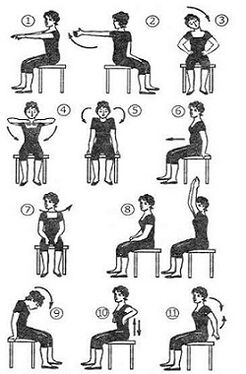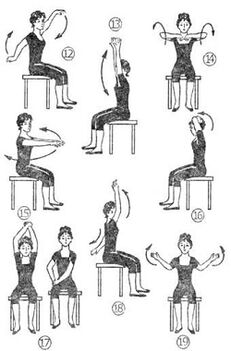
Due to the rigid fixation of the ribs, the thoracic spine is inactive and surprisingly stable, so it is not susceptible to osteocartilage.Its clinical manifestations are very rare in patients with syndrome.
However, some people have been sitting on desktops for years, even in shaky cars, even in uncomfortable, nonviolent positions or steering wheels, “make money” the disease.
Osteochondrosis in the thoracic spine most often falls on people with scoliosis, not following his posture, bent over, hump.
Meanwhile, the breast vertebrae bends with muscles, ligaments, and nerve fibers, which have a lot of tension and experience greater tension and additional, very obvious burden every year.
Fatigue, wear of vertebrae segments, and promote the development of the disease.
Tips:The correctness of the posture is constructed by bonding narrow adhesive wires along the spine.
Once you tilt and your spine is twisted, the adhesive plaster stretches out, reminding you of the need to change your posture and take the right posture.You will be surprised how many times a day you receive postures that are dangerous to your spine health.
Chest osteochondrosis: Symptoms
- Vascular disease is the cause of osteocartilage degeneration, and if there is no obvious cause, the skin will peel, the nails will become very fragile, and the legs will usually be laughing.These are external manifestations of the disease.
- Enhanced bends, limitations of mobility, and burning or cutting pain, spilling between the shoulder strap and the back of the head, with a slight pressure on one of the spicy processes (they are obviously given in the back during the inclination), indicating that the disease progresses.
- The osteocartilage of the thoracic vertebrae and cervical osteocartilage degeneration, and the stimulation of the nerve roots, sandwiched into the narrow spinal canal, may cause chest pain.For example, when a person wakes up from a desk after a workday, it usually appears unexpectedly.It doesn't allow you to breathe, strength, and surprise, it's similar to a stab with a knife behind it.Its nature can sometimes lead to serious cardiovascular disease until coronary artery disease and myocardial infarction.But cardiologists can do nothing here.The cause of the pain is chest osteochondral disease.
- Gastrointestinal syndrome is often concealed as a gastrointestinal disease.The acidity of stomach juice can be significantly reduced.Usually the main complaint of patients with gastroenterologists often address gastroenterology is upper abdominal pain, which is often exacerbated in the afternoon after physical labor and consumption (or fully pass) after a night's rest.Its appearance and enhancement are actually not related to seasonality (as you know, in real patients with gastritis, peptic ulcers, rare fall and spring passes without severe aggravation), food quality and diet.These characteristics of syndrome manifestations help establish a real diagnosis.After treating the underlying disease - the osteocartilage state of the chest and spine, the acidity of the stomach juice recovers without medication.
- If the intervertebral disc at the level of vertebrae at 7-11 has osteocartilage, which is very painful, paroxysmal, paroxysmal, sore, soreness - the lower cartilage spreads to the lower right corner, as if the ribs are injured.During the attack, patients often enter hospitals with multiple diagnoses: acute cholecystitis, renal revenge, pancreatitis, colitis, urolithiasis.
Usually, you have to do the most detailed medical tests to rule out diseases of the abdominal organs and make the correct diagnosis.
Methods for treating thoracic bone tumors
The treatment of osteochondrosis in the thoracic spine depends on the stage of the disease and mainly depends on conservative treatment.Surgical intervention is extremely rare in the case of spinal cord hernia.
- In the stages of aggravating the disease, treatment is designed to relieve pain.To relieve pain, nonsteroidal anti-inflammatory drugs and painkillers are prescribed.To relax muscles and increase spinal mobility, muscle relaxants are prescribed and blood supply to vasodilators are improved.Medication therapy is used in combination with physical therapy and massage.
- In the subordinate stage, treatment is designed to stretch the muscles of the thoracic spine.The most effective way to do a dynamic body is.
- During the remission phase, treatment is designed to improve the mobility of the intervertebral disc, restore the natural curve of the spine and strengthen the muscles in the back.
Treatment of osteochondral toxin in the breast

Exercise for osteochondrosis of the breast must be performed every morning and at night.This complex sits on a chair or stool.We perform all the actions smoothly without sudden actions.Execution is very slow.Breathing is free.
- Sitting in the starting position on the chair, the legs were slightly divorced, and the arms were stretched forward.We squeeze and untied our fingers at 15 to twenty fast speeds.We lowered our hands, leaned forward and shake the brush.
- Starting position sits on a chair, legs, arms along the body.Lift your right hand forward and take it back together with the turn of your body and head.We hold hands at right angles and our eyes follow the movement of our hands.We return to the starting position.We repeat the same on the left.Repeat 3-6 times in each direction.
- Sitting in a chair, legs with broad shoulders and arms.We tilt our heads alternately to our shoulders left and right.Repeat 3-6 times in each direction.
- Starting position sits on a chair, legs and shoulders - shoulder distance, brushes on shoulders, fit the elbow to the side.We lowered and raised our elbows 8-10 times.
- Starting position sits on a chair, legs shoulders - shoulders along the body arms.We performed 5-8 shoulder movements forward and backward in each direction.
- Starting position sits on a chair, legs shoulders - shoulders along the body arms.We breathe and exhale.When inhaling, we stick out our stomachs, and when exhale, we draw it.Repeat 3-4 times.
- Starting position sits on a chair, legs shoulders - shoulders along the body arms.We turn our axis left and right.We repeat each side 3-6 times.
- Starting position sits on a chair with legs together, arms on knees, fingers in the castle.When inhaling, hold your hands above the top of your head while exhale and place it on your knees.Repeat 4-6 times.
- Starting position sits on a chair, legs shoulders - shoulders along the body arms.We leaned our head forward and tried to reach our chin.We return to the starting position.Repeat 6-8 times.
- Starting position sits on a chair, legs shoulders - shoulders along the body arms.We slide our hands along our armpits on inspiration and lower it in our exhale.Repeat 4-6 times.
- Starting position sits on a chair, legs shoulders - shoulders along the body arms.We reduce and dilute the shoulder blade.Repeat 6-8 times.
- Starting position sits on a chair, legs shoulders - shoulders along the body arms.We perform hands movements, just like when each hand swims 6-8 times with a rabbit.
- Starting position sits on a chair, legs shoulders - shoulders along the body arms.Raise our hands through the sides and connect the back of the hands.Inhale - Raise your hand.Exhale - We put our hands down.We will lose 4-5 times.
- Starting position sits in a chair with legs shoulders - shoulders - brush on shoulders, elbows lifted.We perform circular motions in the shoulder joint clockwise and counterclockwise.Repeat 6-8 times in each direction.
- Sitting in the chair at the starting position, legs together and arms forward.We reach our hands to the side - inhale, return to the starting position - exhale.Repeat 3-4 times.
- Starting position sits on a chair, legs shoulders - shoulders along the body arms.Through the side, raise your right hand to your head and touch your ears.We also repeat the movement with our left hand.Repeat each side 4-6 times.
- Starting position sits on a chair, legs shoulders - knees, knees, fingers tightly grasp the "lock".Raise your closed hand - inhale, let us go to our right knee - exhale.We raise our hands - inhale, put it on our left knee - exhale.Repeat 3 times per side.
- Starting position sits on a chair, legs shoulders - shoulders along the body arms.Lift your right hand and move your left hand back at the same time.Change the position of the hand.Repeat 6-8 times.
- Starting position sits on a chair, legs and shoulders - distance width, arms bent at elbows, palms connected.We show the movement of hands, just like swimming with brass.Repeat 6-8 times.

Prevention methods
To avoid exacerbation, prevent pain from occurring:
- Strengthen back muscles;
- Follow your posture;
- Don't catch a cold!
- Dry immediately after exercising or sweating after being wet in the rain.Humidity and cold are the first enemies of your spine.























